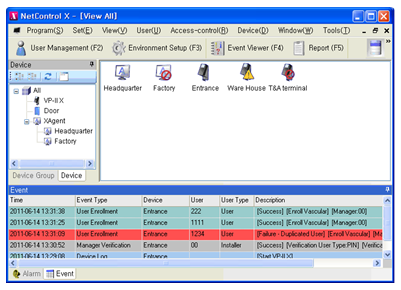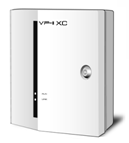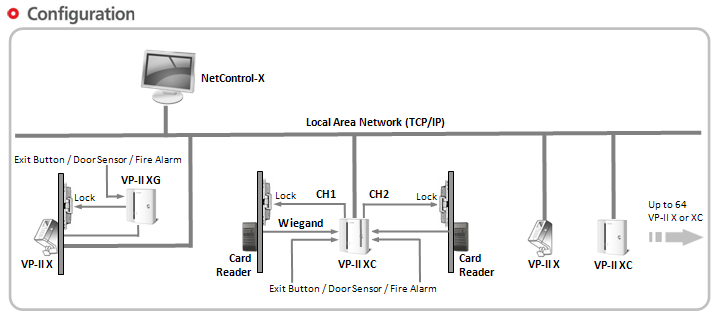Physical Access Control System
NetControl-X Physical Access Control
System
Enterprise Access Control Solution with Hand Vascular
Pattern Recognition
 Techsphere has specialized in Hand Vascular Pattern Recognition (HVPR) biometric technology, including its own access control solution software suite (NetControl) for its HVPR products since its first introduction of the VP-II HVPR products in the year 2001.
Techsphere has specialized in Hand Vascular Pattern Recognition (HVPR) biometric technology, including its own access control solution software suite (NetControl) for its HVPR products since its first introduction of the VP-II HVPR products in the year 2001.
Techsphere’s HVPR products have been successfully deployed and proven in the market with several hundred customers around the world, over many years.
Techsphere’s NetControl-X Physical Access Control System (PACS) is designed for those customers who need a reliable, accurate, and easy to use biometric solution for security access control for highly secured zones, but also want to use non-biometric devices, such as industry standard proximity or smart card readers, for other less secure areas in the facility. NetControl-X PACS provides a complete access control solution for customers without requiring the added cost and additional administration of purchasing and managing a 3rd party access control system.
Key Features and Functions
− Supports VP-II
X Hand Vascular Scanners and/or Card readers – Two channel access
control unit (VP-II XC) for card reader connection
− Real time monitoring
for all devices, locks, doors and access transactions
− Powerful access
control management with NetControl-X software – Timezone control
(Holidays, free access or restricted times), Access rules by user
individually or group, Access granted or denied by doors and/or
areas
− Convenient user
management – By group, location, department or more. Auto-expiration
for visitors or short term users
− Reports for system
logs and access transactions by user, group, device or period.
− Anti-passback
function with two readers installed for in and out
− Up to 64 doors
per location – Multiple locations can be networked
NetControl-X Management Software
 NetControl-X is a Windows based application software for managing VP-II X and/or Wiegand card readers, with an easy and convenient graphic user interface (GUI). NetControl-X monitors and displays the operating status of all devices, doors and locks, all access events and system logs in real time.
NetControl-X allows remote configuration or setup of all devices, remote door open or close, free timezone and restricted timezone per door.
Enrolled users are managed individually or by group for access granted or denied to each door or area by area by different timezone or holidays.
NetControl-X creates or exports reports for system logs and access events with various options, including reports for time and attendance control.
NetControl-X is a Windows based application software for managing VP-II X and/or Wiegand card readers, with an easy and convenient graphic user interface (GUI). NetControl-X monitors and displays the operating status of all devices, doors and locks, all access events and system logs in real time.
NetControl-X allows remote configuration or setup of all devices, remote door open or close, free timezone and restricted timezone per door.
Enrolled users are managed individually or by group for access granted or denied to each door or area by area by different timezone or holidays.
NetControl-X creates or exports reports for system logs and access events with various options, including reports for time and attendance control.
VP-II XC Access Control Unit
 The VP-II XC is a two channel Physical Access Control System (PACS) for Wiegand input devices such as a proximity or smart card reader. The VP-II XC is connected to the NetControl-X application software through TCP/IP Ethernet and operates in the same way as the VP-II X Vascular Scanner for access control functions, the only difference is that the VP-II XC validates only the card ID or PIN from the Wiegand input port, instead of the user’s hand vascular pattern.
The VP-II XC provides connection ports for an electric lock (Dry contact relay outputs), exit button, sensors for door and lock monitoring, and fire alarm input. The VP-II XC provides 12V DC power for the card readers connected to the Wiegand ports. Each channel fully functions independently.
The VP-II XC is a two channel Physical Access Control System (PACS) for Wiegand input devices such as a proximity or smart card reader. The VP-II XC is connected to the NetControl-X application software through TCP/IP Ethernet and operates in the same way as the VP-II X Vascular Scanner for access control functions, the only difference is that the VP-II XC validates only the card ID or PIN from the Wiegand input port, instead of the user’s hand vascular pattern.
The VP-II XC provides connection ports for an electric lock (Dry contact relay outputs), exit button, sensors for door and lock monitoring, and fire alarm input. The VP-II XC provides 12V DC power for the card readers connected to the Wiegand ports. Each channel fully functions independently.
VP-II XG Door Controller
The VP-II XG is a Door Controller for the VP-II X Vascular Scanner. For security reasons, it is strongly recommended that the VP-II XG is located inside, on the secure side of the door; if mounted on the un-secure side of the door, an electric lock may be opened by directly supplying a battery without verifying the user’s hand vascular biometric pattern. The VP-II XG is connected to the VP-II X via RS232 (or RS485 with an optional module).
The VP-II XG also provides connection ports for an electric lock (Dry contact relay outputs), exit button, sensors for door and lock monitoring, and fire alarm input.

Configuration
